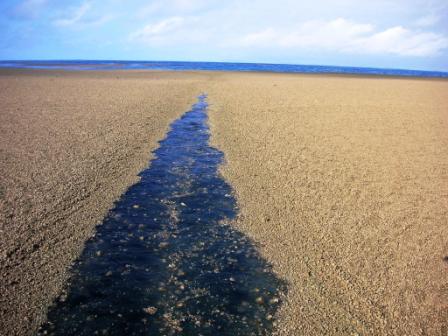
Can Rocks Float?
by Cliff Lamere 28 Dec 2006
A rock is a mixture of minerals. Rocks at the surface of the earth can be seen in different sizes. Sand and pebbles are two of those sizes. Normally, rocks cannot float. They are denser than water, so they sink. However, look at the following.

A yacht has slowly sailed through a floating mass of granular rock, leaving a trail of open water. Looking back, you can see that the open water is beginning to close. Soon, most signs of a disturbance will be gone.
The individual floating grains are the size of sand grains and small pebbles. You can see some pebble-sized rocks floating near the bottom of the photo.
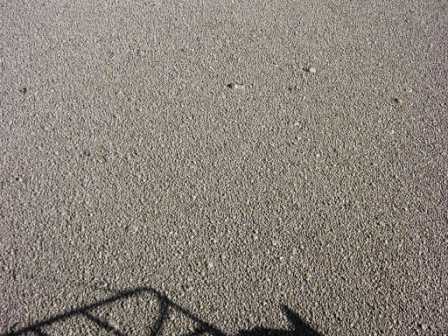
Close-up of the floating particles. Rock particles are categorized according to size. The smallest size is clay, so small that a single grain would be invisible to the human eye. The next larger size is silt, then sand, then pebbles, then cobblestones, then boulders. The floating pieces of rock in the photo look like they are sand and pebbles. There appears to be very little or no floating silt or clay, which is the suspended material in muddy water that can be seen in a creek or river after a significant rain. The evidence for the lack of silt or clay is in the top photo. Where the yacht separated the floating rock particles, the water shows no sign of being muddy in color.
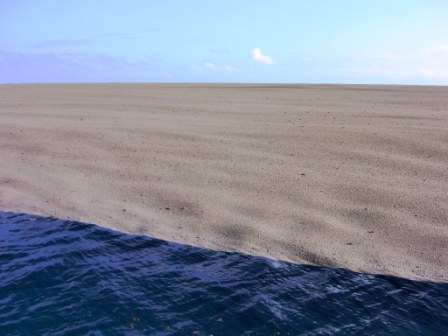
This photo shows the edge of the floating particles. Notice that the surface shows waves gently disturbing the surface of the floating rock. Notice also that the edge of the floating mass where it meets the open water is rather smooth. That indicates that the waves and breeze are moving towards that edge rather than away from it. As seen on the surface of the floating rock particles, the waves are moving from the lower left to the upper right.
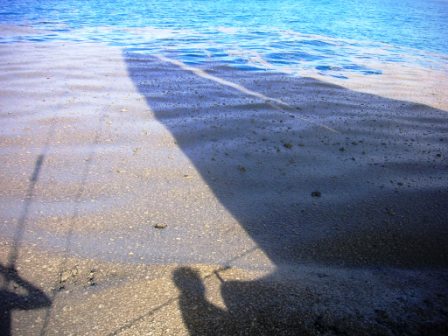
In this photo, the opposite edge of the floating material is seen.
Notice that the waves are moving particles away from the floating mass.
The edge is broken up rather than smooth.
In which direction are the waves moving in this photo?
Where Did The Floating Rock Particles Come From?
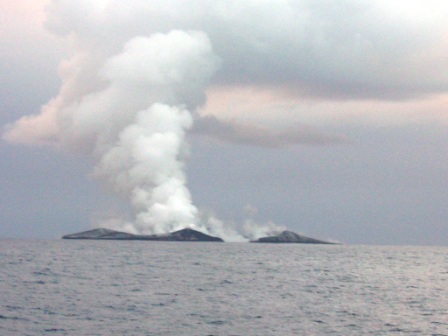
Inside the earth, rock can be heated enough so that it can turn into a liquid which can flow. The liquid rock is called magma until it reaches the surface of land or the ocean bottom. Then it is called lava. Once lava or magma cools and solidifies, it forms IGNEOUS rocks. What are the two other major categories of rocks?
There are many underwater volcanos in the ocean. Some of them keep adding more and more lava to their top and sides until they reach the ocean's surface where they can be seen as islands (which happened in the photo above).
When rock liquefies, gases may form from the chemicals that make up the solid rock. Deep in the earth, the pressure is so great (from all of the rock on top of it) that bubbles of gas cannot form. As the liquid rock nears the surface, there is a lesser weight of rock pressing down on it. As the pressure gets less, the gas bubbles begin to form. As the magma gets near the surface, the bubbles of gas are able to get larger.
If there are a great number of small gas bubbles, or there are a sufficient number of large gas bubbles, chunks of cooled lava can float. Pumice is the name of the most common volcanic rock that floats.
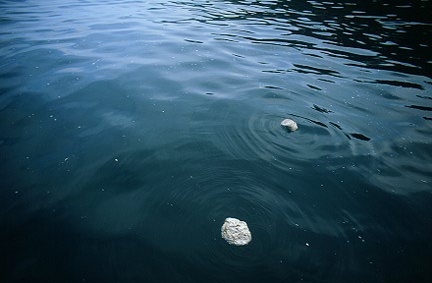
This floating pumice was photographed near the volcano
Krakatoa in Indonesia.
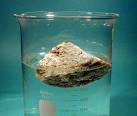
This pumice is floating in a beaker. Pumice is a light-colored rock made out of volcanic glass (no
crystals). Deep in the earth, the same chemicals might have formed granite which is crystalline.
If liquid rock cools slowly enough, there is time for crystals to grow. When it cools rapidly, glass
forms instead. That is the case with pumice.
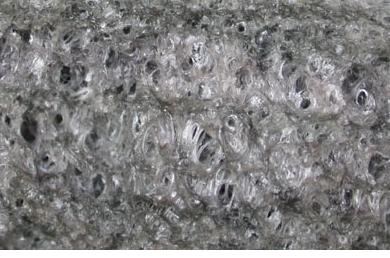 [S]
[S]
Magnified pumice shows its glassy nature, which in not normally seen in pumice held in the hand. There are a large number of small gas holes, as you can see.
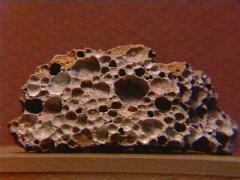 Lava
is most often black when it hardens. The black rock that forms is
called basalt,
Lava
is most often black when it hardens. The black rock that forms is
called basalt,
but when the basalt is full of gas holes it is called scoria. Over a period of time, the
iron in scoria can rust; that turns the rock reddish (as at the left). The holes that form
in scoria can be much larger than in pumice. Gases can be trapped inside of scoria for
centuries. Scientists can test the composition of the gases in the rocks long after the
rocks solidified. Some pieces of scoria can float.
[S]
So..., now you know how it is possible for rocks to float.
_________________________________________________________________
Visitors since 29
Dec 2006
Go to the HOME page